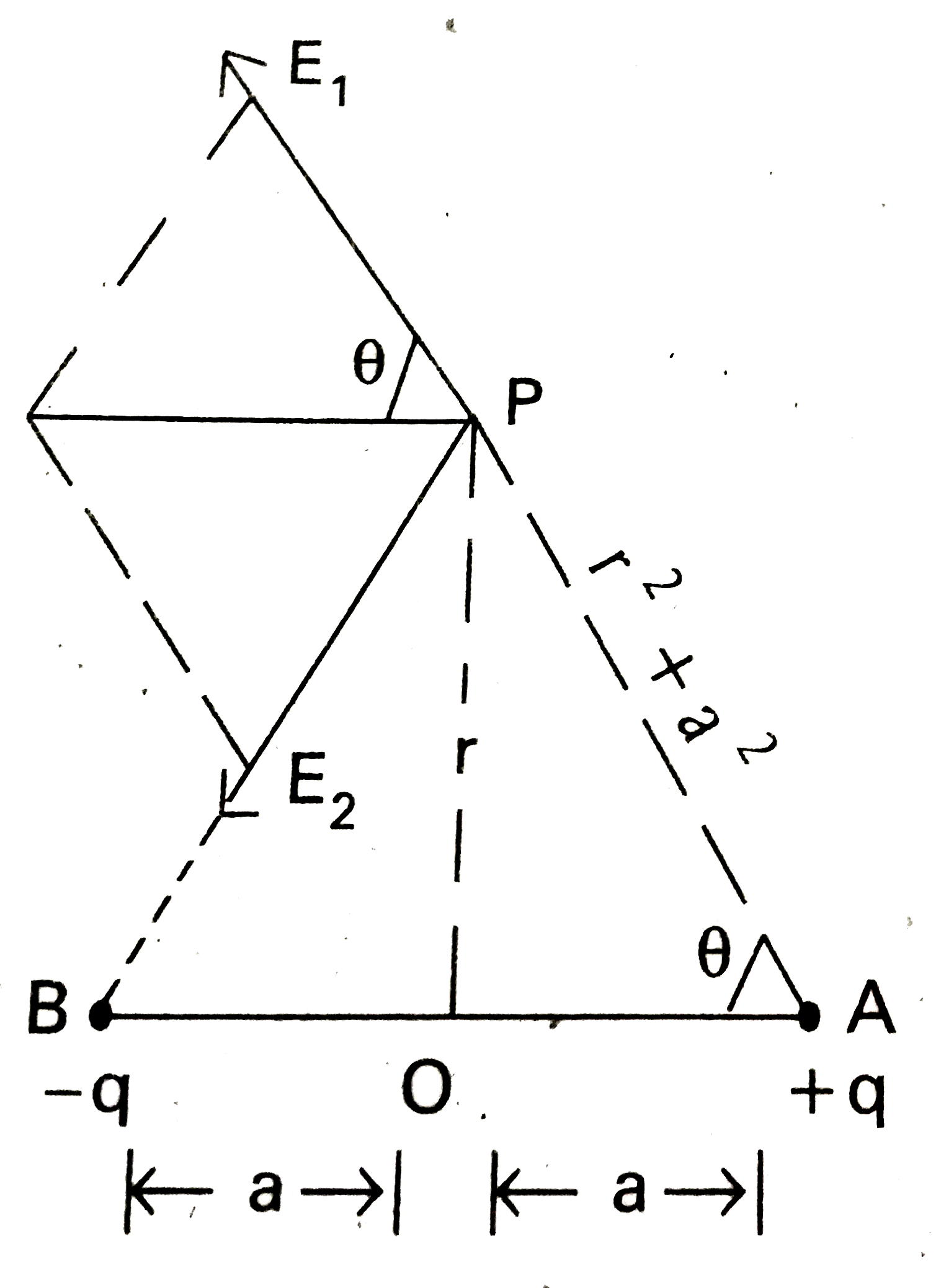Derive an expression for the intensity of the electric field at a point on the equatorial plane of an electric dipole.Solution in Telugu
(1) Consider an electric dipole consisting of two charge -q and +q separated by distance '2a' with centre at 'O'.
(2) We shall calculate electric field E at P on equatorial line of dipole and at a distance OP=r.
(3) Let E1 and E2 be the electric fields at P due to charges +q and -q respectively.
(4) The ⊥r components (E1sinθ and E2sinθ) cancel each other because they are equal and opposite. The IIel components (E1cosθ and E2cosθ) are in the same direction and hence add up.
(5) The resultant field intensity at point P is given by E=E1cosθ+E2cosθ
But E1=E2=14πε0×qAP2=14πspri0×q(r+a)
E=14πε0×q(r+a)[cosθ+cosθ]
=14πε0×2qcosθ(r+a)
(6) From figure, cosθ=a(r2+a2)1/2
∴E=14πε0×2aq(r2+a2)3/2
(7) If r>>a, then a2 can be neglected in comparison to r2. Then
E=P4πε0×1r3
In vector form →E=→P4πε0r3

Topper's Solved these Questions
- BOOK - VIKRAM PUBLICATION ( ANDHRA PUBLICATION)CHAPTER - ELECTRIC CHARGES AND FIELDSEXERCISE - LONG ANSWER QUESTIONS3videos
ELECTRIC CHARGES AND FIELDS
- BOOK - VIKRAM PUBLICATION ( ANDHRA PUBLICATION)CHAPTER - ELECTRIC CHARGES AND FIELDSEXERCISE - TEXTUAL EXERCISES11videos
ELECTRIC CHARGES AND FIELDS
- BOOK - VIKRAM PUBLICATION ( ANDHRA PUBLICATION)CHAPTER - ELECTRIC CHARGES AND FIELDSEXERCISE - VERY SHORT ANSWER QUESTIONS13videos
ELECTRIC CHARGES AND FIELDS
- BOOK - VIKRAM PUBLICATION ( ANDHRA PUBLICATION)CHAPTER - DUAL NATURE OF RADIATION AND MATTEREXERCISE - DAM SURE (VSAQ)2videos
DUAL NATURE OF RADIATION AND MATTER
- BOOK - VIKRAM PUBLICATION ( ANDHRA PUBLICATION)CHAPTER - ELECTROMAGNETIC INDUCTION EXERCISE - Additional EXERCISES15videos
ELECTROMAGNETIC INDUCTION
Similar Questions
Define electric flux. Applying Gauss's law and serive the expression for electric intensity due to an infinite long straight charged wire. (Assume that the electric field everywhere radial and depends only on the radial distance r of the point from the wire.)
07:05View SolutionTwo small identical balls, each of mass 0.20 g, carry identical charges and are suspended by two threads of equal lengths. The balls position themselves at equilibirum such that the angle between the threads is 60∘. If the distance between the balls is 0.5 m, find the charge on each ball.
07:45View SolutionWhat is meant by the statement 'charge is quantized' ?
09:19View SolutionThe wavelength of electromagnetic radiation is doubled. What will happen to the energy of the photons of the new radiation ?
09:19View SolutionSuppose the loop in Textual Exercise 4 is stationary but the current feeding the electromagnet that produces the magnetic field is gradually reduced so that the field decreases from its initial value of 0.3 T at the rate of 0.02Ts−1 .If the cut is joined and the loop has a resistance of 1.6Ω how much power is dissipated by the loop as heat ? What is the source of this power ?
08:39View SolutionDerive an expression for the intensity of the electric field at a point on the axial line of an electric dipole.
15:39View SolutionDefine electric dipole moment. Is it a scalar or a vector? Derive the expression for the electric field of a dipole at a point on the equatorial plane of the dipole.
12:28View SolutionObtain an expression for the electric field intenstiy at a point on the equatorial line of an electric dipole.
06:06View SolutionObtain an expression for the electric field intenstiy at a point on the equatorial line of an electric dipole.
05:34View SolutionCalculate the electric field due to a dipole on its equatorial plane. (OR) Electric field due to an electric dipole at a point on the equatorial plane
03:11View SolutionWrite the definition of electric dipole moment. Is it a scalar or a vector? Derive the expression for the electric field of the dipole at a point on the equatorial plane of a dipole.
11:53View SolutionDerive an expression for the electric field it a point on the equatorial line of an electric dipole.
04:45View SolutionDerive an expression for intensity of electric field are a point in broadside position or on an equatorial line of an electric dipole.
View SolutionDerive an expression for electric field intensity at a point on the axial line of an electric dipole.
View SolutionDerive the expression for the electric field intensity due to an electric dipole at any point on its equatorial line.
View Solution

